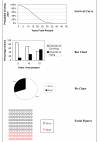Discussing life expectancy with surgical patients: do patients want to know and how should this information be delivered?
- PMID: 18554419
- PMCID: PMC2440736
- DOI: 10.1186/1472-6947-8-24
Discussing life expectancy with surgical patients: do patients want to know and how should this information be delivered?
Abstract
Background: Predicted patient life expectancy (LE) and survival probability (SP), based on a patient's medical history, are important components of surgical decision-making and informed consent. The objective of this study was to assess patients' interpretation of and desire to know information relating to LE, in addition to establishing the most effective format for discussion.
Methods: A cross sectional survey of 120 patients (mean age = 68.7 years, range 50-90 years), recruited from general urological and surgical outpatient clinics in one District General and one Teaching hospital in Southwest England (UK) was conducted. Patients were included irrespective of their current diagnosis or associated comorbidity. Hypothetical patient case scenarios were used to assess patients' desire to know LE and SP, in addition to their preferred presentation format.
Results: 58% of patients expressed a desire to know their LE and SP, if it were possible to calculate, with 36% not wishing to know either. Patients preferred a combination of numerical and pictorial formats in discussing LE and SP, with numerical, verbal and pictorial formats alone least preferred. 71% patients ranked the survival curve as either their first or second most preferred graph, with 76% rating facial figures their least preferred. No statistically significant difference was noted between sexes or educational backgrounds.
Conclusion: A proportion of patients seem unwilling to discuss their LE and SP. This may relate to their current diagnosis, level of associated comorbidity or degree of understanding. However it is feasible that by providing this information in a range of presentation formats, greater engagement in the shared decision-making process can be encouraged.
Figures



References
-
- American Society of Anesthesiologists New Classification of Physical Status. Anesthesiology. 1963;24:111.
MeSH terms
LinkOut - more resources
Full Text Sources

